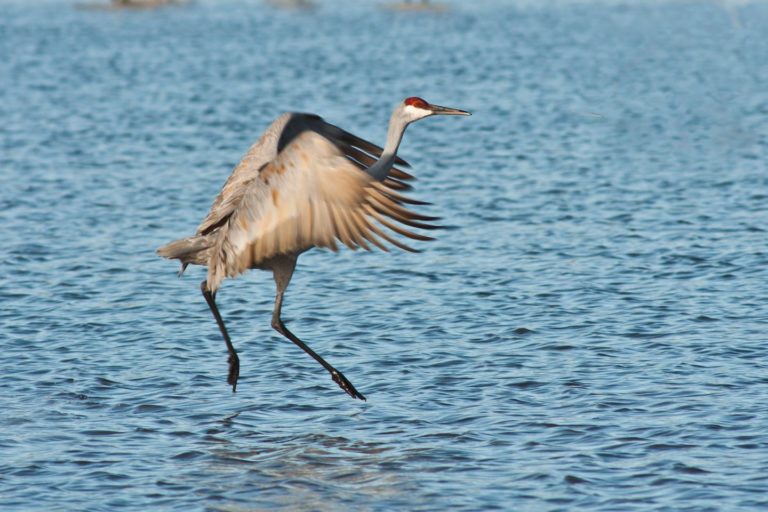- Calculating a moving average is a common way researchers “smooth” out the irregularities in year-to-year counts produced by the way the counts are actually performed.
- Yet this method has never been subjected to much scrutiny, according to Brian Gerber of Colorado State University and William Kendall of the U.S. Geological Survey, the authors of a study published late last month in the journal The Condor: Ornithological Applications.
- Gerber and Kendall used the results of 31 annual surveys of sandhill cranes (Antigone canadensis) in North America’s Rocky Mountains to examine how accurate moving averages really are, then compared those results to the estimates produced by a more advanced statistical approach known as a hierarchical Bayesian time series (HBTS) model.
New research that takes a look at the reliability of traditional survey methods finds that there are ways to improve how wildlife populations are estimated.
In order to properly design measures for the preservation of a particular species, one fundamental piece of information you need to know is how many individuals are left in the population you’re seeking to protect, of course. Acquiring that data is not simply a matter of going out into the field and counting every single animal in a given population, however, as that would be difficult if not impossible in most cases, as well as costly.
Observational surveys done in the field can vary from year to year based on how the animals are actually counted — for instance, the time of year might be different from one count to the next, or the species being studied might migrate at slightly different times of the year, meaning the count could be off because of the number of animals available to be counted, not because of an actual change in the population size.
One of the chief ways researchers seek to reduce the variation in their annual counts, known as “smoothing” their data, is by using a three-year moving average, in which the latest three years of counts are averaged together. As another year’s count is added to the dataset, the most current three years are averaged to arrive at the latest “smoothed” population number.
There are other ways to account for the limitations of such time-series population data, such as tagging individual animals and doing a capture-recapture estimation. But a moving average is a common tool researchers use to smooth out the irregularities in their year-to-year counts produced by the way the counts are actually performed.
Yet this method has never been subjected to much scrutiny, according to Brian Gerber of Colorado State University and William Kendall of the U.S. Geological Survey, the authors of a study published late last month in the journal The Condor: Ornithological Applications.
Gerber and Kendall used the results of 31 annual surveys of sandhill cranes (Antigone canadensis) in North America’s Rocky Mountains to examine how accurate moving averages really are, then compared those results to the estimates produced by a more advanced statistical approach known as a hierarchical Bayesian time series (HBTS) model.
“We compared the different estimation methods (three-year average and HBTS) by using a mechanistic population model of sandhill cranes (i.e., based on survival, recruitment, and harvest),” Gerber told Mongabay. “We evaluated whether the changes in the population estimates using the count data were realistic, given what we know about sandhill crane population dynamics.”
Gerber says that he and Kendall simulated “imperfectly observed” population dynamics and then evaluated which methods produced the more accurate estimates of the sandhill crane population size. “We found the HBTS model produced more realistic population estimates under a wide array of population trajectories (population decline, population increase, population increase and decline),” he said.
Using a Bayesian approach allowed Gerber and Kendall to include additional information that they already knew about sandhill crane population dynamics as well as about how sandhill cranes are counted. “Namely, that their population growth is fairly small and the variables that affect how cranes are counted can likely causes changes in population counts to a greater extent than true population changes,” Gerber said. “By including this information we can constrain the model in biological ways to hopefully produce more realistic predictions.”
There are a number of other advantages to the HBTS model, according to Gerber. For one thing, the HBTS model offers a measure of uncertainty about population estimates, which isn’t provided by a three-year moving average, he said. The Bayesian approach can even be used to predict a population size in years when a survey can’t be done, “providing information to resource managers who are charged with making complex decisions about animal populations,” Gerber noted.
In a statement accompanying the publication of the study, Gerber said that he and Kendall’s findings suggest that collecting long-term population data is not only worthwhile for crane management (goals for maintaining sandhill crane populations in the Rocky Mountains appear to have been met, based on the available evidence), but that the more sophisticated statistical method can be applied to other species, as well.
“Looking forward,” he said, “managers may still be interested in adopting our more robust modeling approach due to its flexible framework, which makes implementing any changes relevant to the survey easier.”

CITATION
- Gerber, B. D., & Kendall, W. L. (2017). Evaluating and improving count-based population inference: A case study from 31 years of monitoring Sandhill Cranes. The Condor, 119(2), 191-206. doi:10.1650/CONDOR-16-137.1